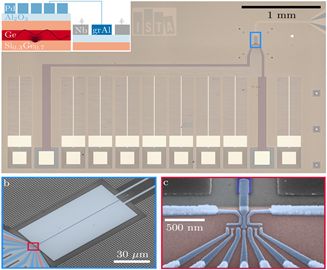The development of quantum computers is currently facing a crucial technological challenge: how to scale existing systems from a few hundred quantum bits (qubits) to millions on a single chip. Spins of elementary charges confined in quantum dots are considered a promising candidate for scaling qubits, mainly due to their compact size but also for their long coherence and tunable properties. However, this type of qubit has a significant limitation: its natural coupling is mediated by a short-range (approximately 100 nm) quantum exchange interaction, limited to nearest neighbors.
To overcome this limitation and allow communication between qubits separated by longer distance, it is necessary to engineer long-range (approximately 1 mm) qubit quantum interactions. This interaction could be mediated by photons through coherent spin-photon coupling. “Achieving strong coupling between a photon and a charge in a quantum dot has so far been very challenging due to the small dipole moment of the confined charge,” says Marián Janík from the Institute of Electrical Engineering of the Slovak Academy of Sciences. “However, this problem can be mitigated by using high-impedance superconducting resonators, which effectively increase the electric field of a photon. Granular aluminum allows us to achieve extremely high impedances, significantly enhancing spin-photon coupling potential.”
Granular aluminum (grAl) with superconducting resonators appears to be a promising solution for increasing coupling strengths between quantum dots and photons, thus gaining significant attention in the past decade. Previous attempts in circuit quantum electrodynamics with quantum dots failed to exceed an impedance of 4 kΩ. However, using resonators out of granular aluminum, which consists of randomly grown 5 nm grains, offers the potential to significantly increase this impedance. Granular aluminum provides high kinetic inductance, which enables an order-of-magnitude increase in resonator impedance, leading to stronger spin-photon coupling.
The main challenge when using disordered superconducting materials is the reproducibility of fabrication. “We found a solution to this problem,” explains Janík, “by developing a new wireless ohmmeter that allows resistance measurement during thin-film deposition, indirectly controlling its properties.” He adds, “This approach enables us to reproducibly fabricate superconducting resonators with an impedance of up to 22 kΩ, nearly six times higher than previously achieved. This opens up new possibilities in quantum technologies.”
“By integrating an 8 kΩ grAl resonator with a germanium-based quantum dot, we achieved strong coupling between a single elementary charge (a hole) and a single photon, with the highest recorded coupling rate of 566 MHz. This advancement represents a significant step forward in quantum technology, offering a promising approach to achieving long-range qubit operations necessary for the realization of quantum computers.”
The demonstrated methods, together with the exceptional properties of granular aluminum, open the door to a new era of quantum circuits, where strong spin-photon coupling can be harnessed for the next generation of quantum technologies. “Strong spin-photon coupling is a key element for realizing fast, high-fidelity, two-qubit operations over long distances,” Janík emphasizes, which is a fundamental requirement for the practical use of quantum computers in real-world applications.

a) Granular Aluminum and integration of a resonator with a double quantum dot in a germanium heterostructure
b) Detail from Fig. a) highlighted with a blue rectangle. c) Detail from Fig. b) highlighted with a red rectangle.
More info: Janík, M., Roux, K., Borja-Espinosa, C. et al. Strong charge-photon coupling in planar germanium enabled by granular aluminium superinductors. Nat Commun 16, 2103 (2025). https://www.nature.com/articles/s41467-025-57252-4





